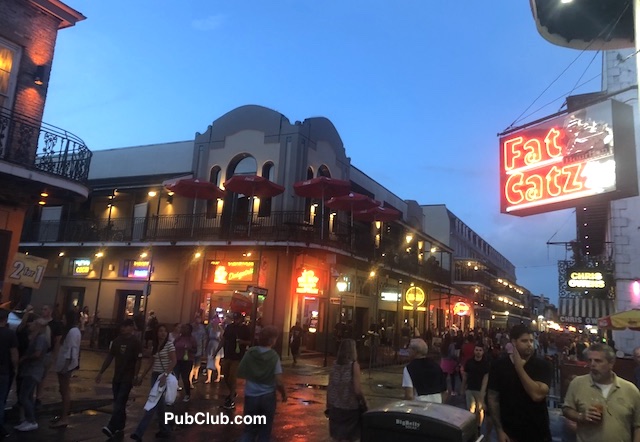
By Kevin Wilkerson, PubClub.com New Orleans Blogger
Before racing out to Bourbon Street, get to know New Orleans with this informative orientation guide. Meet the people here, lean what to expect, what to wear, how to get around town and more.
The French Quarter, which hardly had any flooding at all to begin with, is vibrant. The restaurants are all serving their tremendous uniquely-New Orleans dishes, bands are playing in the bars on Bourbon Street and the shops are selling the usual items from outlandish Mardi Gras beads to fine artwork.
New Orleans Arrival and Orientation Information
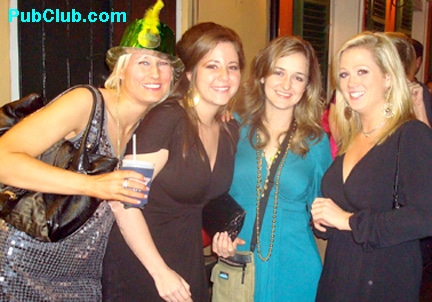
New Orleans’ Louis Armstrong airport is served my all major airlines. Taxis have a flat rate to downtown/the French Quarter of $36 for one or two, or $15 each for 3 or 4 people. Uber and Lyft are around $45 tho it depends on the time of day, what event is happening and other factors. The on-site Airport Shuttle is $24 each way or $44 round trip. For those arriving by car, Interstate 10 is the main East-West thoroughfare running into town.
It’s not necessary to rent a car in New Orleans, as taxis and feet work fine for transportation.
The first order of business for newcomers is to get a map. New Orleans is a simple city to navigate, though North/South and East/West directions are seldom used. In fact, one of the few directional symbols is the Robert E. Lee statue at Lee Circle. Legend has it that he is facing defiantly to the North (there are legendary stories about just about everything in New Orleans). Use the Mississippi River as a natural boundry.
Canal Street is the main thoroughfare, and has been for quite some time. It was originally designed to be a canal but the engineer ran off with the money and it became a street instead. In the city’s early years, it was the dividing line between the French and the Americans. That’s why the same streets have different names on each side of Canal (Bourbon becomes Carondlet, Royal is St. Charles, Decatur is Magazine, and so forth). Eventually, the two sides realized it was better to join together than to fight and the city became a united mix of people from America, France, Africa and the Caribbean. New Orleans is a unique melting pot of cultures.
Beside the French Quarter, other parts of town are Uptown and the Garden District. Uptown is just a few cable stops from Canal Street and contains some very cool bars and restaurants. The Garden District is home to the stately mansions of New Orleans lore, in essence an antebellum suburb. It hugs St. Charles Ave. from Jackson Ave., to Louisiana Ave. Magazine Street, home of the excellent National D-Day Museum, is an up-and-coming area.
Where to Stay In New Orleans
Most people spend most of their time in and around the French Quarter. There are several hotels – big and small, chain and mom-and-pop – throughout this area.
When inquiring about accommodations, check and see how far the hotel is from Bourbon Street. Anything beyond N. Rampart on one side (North) or Poydras on another (West) is a bit of a hike. It’s also not a good idea venture past N. Rampart for safety reasons (see Crime and Safety, below).
There are basically two types of hotels in New Orelans: Classic and upscale. The former really defines the French Quarter, modestly-sized red brick buildings with iron balconies. There are dozens in the city and many are 4- and 5-star choices (there are budget choices, as well). Two excellent choices in this area are the Hotel Montleone and Le Richelieu.
The Hotel Monteleone dates to 1886 and is still a family-run property. It features well-appointed singles, doubles, mini-suites and literary suites,, two restaurants and the famous Carousel Bar that actually rotates around to provide views of Royal Street, the piano lounge and the beautiful lobby. It’s heritage is built on the famous authors who have stayed here – Tennessee Williams, Truman Capote, William Faulkner, just to name a few, and provides literary readings over lunch once a month. Room rates range from $200-400. Reservations: ( 800) 535-9595.
On the other end of the Quarter, the LeRichelieu, is a historic hotel which defines the word “charming.” Located adjacent to the French Quarter on Chartres Street, its guests have included Jimmy Buffett and Paul McCartney. Each room is different but they all contain a refrigerator and is one of the city’s best higher-end hotel bargains. Free parking– a rare luxury in big cities these days – is a huge bonus for those with rental cars. Reservations:( 800) 535-9653.
On the modern scale, it’s hard to beat the quality, location and knockout view of the Mississippi River at the Wyndham at Canal Place. Reservations: (800) 996-3426 or (504) 566-7006.
Prices vary widely and for accommodations during Mardi Gras, Jazz Fest or special events, book early.
Getting To Know The French Quarter
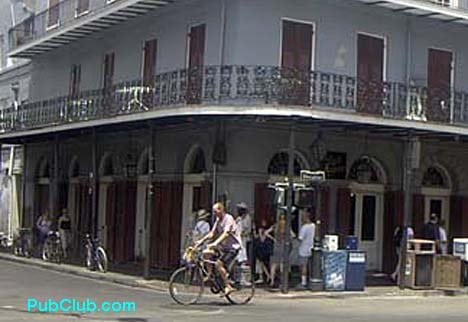
The French Quarter contains a statue to Joan of Ark and artists along Jackson Square.
Bordered by Canal Street, N. Rampart, the Esplanade and the Mississippi River, the French Quarter – or simply “the Quarter” – is the heartbeat of New Orleans.
It is in this easily-walkable area that most of the city’s bars, restaurants and landmarks are located. Yes, that includes world-famous Bourbon Street.
But it also includes Jackson Park, Cafe du Monde and all manner of restaurants, bars and shops.
Bourbon Street is, of course, it’s most famous spot and is lined with bars, balconies and drinkers. Royal Street, just one block over, is much more stately and contains many of the city’s most upscale shops and galleries. Chartres is a PubClub favorite, a street traveled much more by locals than by tourists. On it are a couple of cool distinctively local bars, the Chart Room and Napoleon House. Decatur Street is where most non-Bourbon tourists patrol, often headed to Jackson Square, Cafe du Monde, the French Market, the many restaurants or Margaritaville Cafe.
Getting Around New Orleans
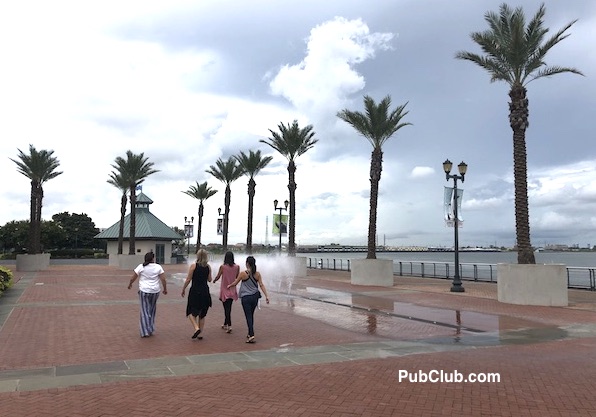
A comfortable pair of shoes is much more important than car keys in New Orleans. This is a city made for walking. In fact, even attempting to drive would invite frustration not only for the visitors but for the locals, as well.
Not that the locals drive all that well. In fact, they drive like they party – wild and uninhibited. They seem to get a thrill out of chasing down pedestrians, forcing them to scramble to the sidewalk just as the car passes, like a cat that barely makes it inside the door as it shuts. Just like the cat, everyone seems to make it safely to the destination.
Taxis are readily available, although the drivers don’t exactly possess “The Knowledge” of the street -savvy London cabbies. So, if possible, provide at least the general area of a destination (cross streets work fine).
When out of the French Quarter, don’t be afraid to ride the Street Car. The St. Charles Line goes down one of America’s most famous streets. Get off and tour the Tulane University campus. Use it to hop from Uptown bar to bar. Or just take it for a leisurely ride. Just be sure to have the $1.25 exact change ($5 for an all-day pass or $12 for three days). There is also a line that runs along the Riverfront and the city is constructing a Canal Street line. For more on the the Street Car, see our Post Party section or use it for a very cool pub crawl to visit the locals’ Uptown bars.
The Party Scene/Dress Codes In New Orleans Bars

Think casually wild.
That is, dress casually and go wild.
First, the dress code. Shorts, sandals, t-shirts, skirts and other low-key attire are all acceptable, even in many of the best restaurants. It’s Key West casual because, like the Conch Republic, the sticky, hot weather makes comfort much more preferable to style.
As far as the party scene, there are very few rules. For starters, there is no last call. At some places, the bands don’t even begin playing until 3 a.m. – even on Sundays.
Cocktails of all concoctions are sold everywhere and it’s perfectly legal to drink on the streets. New Orleans has a wonderful “drink-to-go” policy. Get a drink in a bar and if you don’t finish it there, pour it in a plastic”to go” cup and head someplace else. Most places even allow people to bring in those drinks. On Bourbon Street, there are so many bars packed in such a confined area that part of the adventure is weaving in and out of the places like Jeff Gordon making his way through lapped traffic at the Daytona 500.
New Orleans takes bar hopping to a whole new level. Not surprisingly, people become quite intoxicated. Yet nobody seems to care. The police stand by while people stagger down the street and only step in if there is a problem. Rarely – amazingly, some might say – the problems are few and far between. That’s because the city has been doing this for so long, it has created the perfect party environment. Revelers know this, respect this and leave their bad behavior behind.
The Mardi Gras Beads
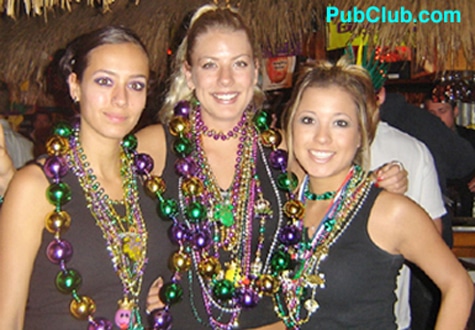
It wouldn’t be New Orleans without Mardi Gras beads.
Beads are to New Orleans what leis are to Hawaii. They are everywhere and people do indeed line the Bourbon Street balconies either to give them out or to collect them. Girls “earn” beads by lifting their tops to expose their breasts; there is no shortage of guys encouraging them to do so. This is a New Orleans tradition that peaks at Mardi Gras but lasts throughout the year. Tourist Tips: Locals don’t wear beads and while dozens of places sell them on Bourbon Street, they are cheaper on Decatur and at the French Market.
The People Of New Orleans
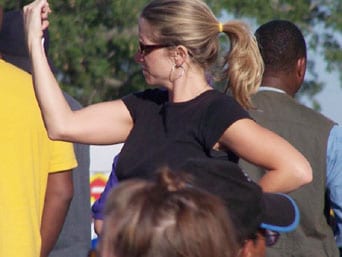
New Orleans natives love to party and don’t mind sharing the city with visitors.
One of the coolest things about New Orleans is the people. From waiters and waitresses to hotel doormen, bartenders to bar patrons, tourists to locals, people here are just plain friendly. Maybe it’s because they either have a drink in their hand or on their way to get one.
Locals, who speak in kind of a French-accented English with an Old South spin called “Cajun,” are an interesting group. They seem to weave through life with little worries, absolutely love their music and have the uncanny ability to party until sunrise and wake up the next day as if they had spent the previous evening watching “American Idol.” They are as natural in a bar as Tiger Woods on a golf course. Add a live band and they truly in their element.
There is also no visible evidence of racial tension in the city. There is no attention paid to anyone’s race, religion or origin. Regardless of one’s ethnicity or background, people are friendly to everyone (even tourists!) and are always smiling. New Orleans sure has it right when it comes to treating and hosting people.
Nobody Does Voodoo Like You Do/New Orleans Myths & Legends
Few cities anywhere in the World possess New Orleans’ interesting subcultures. On every street corner, it seems, is one supposedly legendary story about a past life, person or event. Many involve tales of ghosts and haunted houses and voodoo is no mystery here.
Then there is the music. New Orleans is King of Music. While there is some dispute as to what city is the birthplace of Jazz, there can be no argument that it thrives here. Other types of music also flourish – zydeco, Cajun bluegrass, brass bands and rock. In New Orleans, these sounds fill the streets and bars, day and night.
Voodoo, by the way, was born of religion and became part of New Orleans’ culture in the 1830s when a local lady by the name of Marie Laveau began a series of rituals, which seemed to cure the city’s aristocratic women of their problems.The Voodoo Museum is a good place to learn more and experience this New Orleans tradition.
Safety and Crime in New Orleans
For the most part, New Orleans is safe. This is the case even after Katrina. The biggest dangers in the prime tourist areas have always been and continue to be stumbling drunk into an oncoming vehicle or a lightpost or simply falling down in the street.
Most crimes involving tourists are pickpockets and petty theft, but use common sense and stay alert. With many heavily inebriated partiers, Bourbon Street can indeed present prizes to purse and wallet thiefs. particularly during big events.If a particularly big parting evening is planned, leave the purse and wallet behind. Take cash and one credit card – plus an ID if needed – in a front pants pocket.
However, this is a major American city and one of the bummers of life in this country is that big cities invite crime. Be aware of the surroundings while at ATMs. The area just beyond N. Rampart on the French Quarter side of Canal Street is the ghetto and an unsuspecting tourist – especially one that has been living it up Bourbon Street – would make for a tempting target. In the infamous Lower 9th Ward, where the worst of Katrina flooding occurred, many gangs have set up shop and drug-related deaths have become somewhat common. But it’s so far removed from the French Quarter in both lifestyle and distance that it’s not at all on the mental map for visitors.
When visiting Uptown, stay to the safety of St. Charles Street at night. Small groups of girls can be vulnerable.
Weather/When to Go To New Orleans
The party rages nearly year-round in New Orleans, so anytime is a great time to visit.
The wildest parties are Mardi Gras in late February/early March (depending on Lint and Fat Tuesday) and Jazz Fest in late April/early May. And, of course, there is New Year’s Eve, which PubClub ranks as the World’s #1 NYE Party Destination. The city also hosts several conventions and room rates adjust accordingly. Summer months are slow by comparison.
The weather is warm and the humidity is high. In the winter months, the temperatures are mild, averaging in the mid-60s. There can be days when it drops to the 30s, but it’s just as likely to be 70 the next day. The summers can be really hot. Hurricane season runs from June 1-Nov. 30, with October traditionally being the most active month.
Next Stop On The New Orleans Party Bus: PubClubbing In The Bourbon Street Bars!
PubClub.com covers nightlife, bars, festivals and party events around the world. I have been to New Orleans many times.